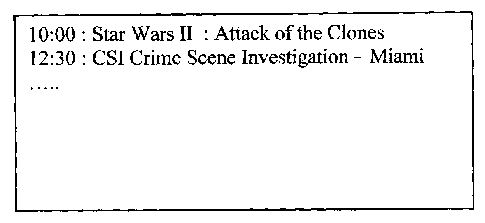Some of the information on this Web page has been provided by external sources. The Government of Canada is not responsible for the accuracy, reliability or currency of the information supplied by external sources. Users wishing to rely upon this information should consult directly with the source of the information. Content provided by external sources is not subject to official languages, privacy and accessibility requirements.
Any discrepancies in the text and image of the Claims and Abstract are due to differing posting times. Text of the Claims and Abstract are posted:
| (12) Patent Application: | (11) CA 2595797 |
|---|---|
| (54) English Title: | METHOD FOR PROCESSING A SCHEDULE OF EVENTS BROADCAST BY A PROVIDER |
| (54) French Title: | PROCEDE DE TRAITEMENT D'UNE GRILLE D'EVENEMENTS DIFFUSES PAR UN FOURNISSEUR |
| Status: | Deemed Abandoned and Beyond the Period of Reinstatement - Pending Response to Notice of Disregarded Communication |
| (51) International Patent Classification (IPC): |
|
|---|---|
| (72) Inventors : |
|
| (73) Owners : |
|
| (71) Applicants : |
|
| (74) Agent: | GOWLING WLG (CANADA) LLP |
| (74) Associate agent: | |
| (45) Issued: | |
| (86) PCT Filing Date: | 2006-03-01 |
| (87) Open to Public Inspection: | 2006-09-08 |
| Availability of licence: | N/A |
| Dedicated to the Public: | N/A |
| (25) Language of filing: | English |
| Patent Cooperation Treaty (PCT): | Yes |
|---|---|
| (86) PCT Filing Number: | PCT/EP2006/060358 |
| (87) International Publication Number: | EP2006060358 |
| (85) National Entry: | 2007-07-23 |
| (30) Application Priority Data: | ||||||
|---|---|---|---|---|---|---|
|
The invention concerns the display of a list of television events and their
access modes. The invention concerns a method for processing a list of events
broadcast by a provider in particular pay television events, said schedule
being designed to be displayed on at least one multimedia unit, including the
following steps: creating and broadcasting to the multimedia unit, a first
list of events broadcast by said provider, said list comprising at least data
describing the events and an identifier of the event. Said method is
characterized in that it includes the following additional steps: creating and
broadcasting a second list comprising for a given event identifier, at least
one subscription mode identifier; creating and broadcasting a third list
comprising for each subscription mode identifier, data describing said
subscription mode.
Cette demande concerne l'affichage d'une liste d'événements télévisuels et leurs modes d'accès. Cette demande concerne un procédé de traitement d'une liste d'événements diffusés par un fournisseur notamment d'événements de télévision à péage, cette grille étant destinée à être affichée sur au moins une unité multimédia, comportant les étapes suivantes : - création et diffusion à destination de l'unité multimédia, d'une première liste des événements diffusés par ledit fournisseur, cette liste comprenant au moins des données descriptives des événements et un identifiant de l'événement; ce procédé étant caractérisé en ce qu'il comprend les étapes additionnelles suivantes: - création et diffusion d'une seconde liste comprenant pour un identifiant d'événement donné, au moins un identifiant de mode de souscription, - création et diffusion d'une troisième liste comprenant pour chaque identifant de mode de souscription, des données descriptives dudit mode de souscription.
Note: Claims are shown in the official language in which they were submitted.
Note: Descriptions are shown in the official language in which they were submitted.

2024-08-01:As part of the Next Generation Patents (NGP) transition, the Canadian Patents Database (CPD) now contains a more detailed Event History, which replicates the Event Log of our new back-office solution.
Please note that "Inactive:" events refers to events no longer in use in our new back-office solution.
For a clearer understanding of the status of the application/patent presented on this page, the site Disclaimer , as well as the definitions for Patent , Event History , Maintenance Fee and Payment History should be consulted.
| Description | Date |
|---|---|
| Inactive: IPC assigned | 2016-03-16 |
| Inactive: First IPC assigned | 2016-03-16 |
| Inactive: IPC expired | 2011-01-01 |
| Inactive: IPC expired | 2011-01-01 |
| Inactive: IPC expired | 2011-01-01 |
| Inactive: IPC removed | 2010-12-31 |
| Inactive: IPC removed | 2010-12-31 |
| Inactive: IPC removed | 2010-12-31 |
| Application Not Reinstated by Deadline | 2010-03-01 |
| Time Limit for Reversal Expired | 2010-03-01 |
| Deemed Abandoned - Failure to Respond to Maintenance Fee Notice | 2009-03-02 |
| Inactive: Cover page published | 2007-10-10 |
| Inactive: Notice - National entry - No RFE | 2007-10-05 |
| Inactive: First IPC assigned | 2007-08-30 |
| Application Received - PCT | 2007-08-29 |
| National Entry Requirements Determined Compliant | 2007-07-23 |
| Application Published (Open to Public Inspection) | 2006-09-08 |
| Abandonment Date | Reason | Reinstatement Date |
|---|---|---|
| 2009-03-02 |
The last payment was received on 2008-02-15
Note : If the full payment has not been received on or before the date indicated, a further fee may be required which may be one of the following
Patent fees are adjusted on the 1st of January every year. The amounts above are the current amounts if received by December 31 of the current year.
Please refer to the CIPO
Patent Fees
web page to see all current fee amounts.
| Fee Type | Anniversary Year | Due Date | Paid Date |
|---|---|---|---|
| Basic national fee - standard | 2007-07-23 | ||
| MF (application, 2nd anniv.) - standard | 02 | 2008-03-03 | 2008-02-15 |
Note: Records showing the ownership history in alphabetical order.
| Current Owners on Record |
|---|
| NAGRAVISION S.A. |
| Past Owners on Record |
|---|
| PHILIPPE STRANSKY |